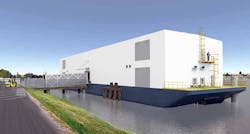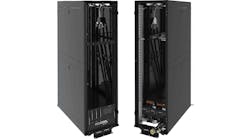The floating data center has taken a big step closer to becoming a reality. Nautilus Data Technologies has lined up $100 million in funding that will allow it to complete a 6-megawatt floating colocation facility that it says will be cheaper and more efficient than traditional land-based facilities.
Nautilus seeks to tap rivers, lakes and oceans to slash the cost of cooling servers. It is the latest developer to pursue a water-based data center, a novel concept that has made headlines since Google first floated the idea in a 2007 patent filing, and was spotlighted by Microsoft’s deployment of an undersea data center.
The company has spent the last five years seeking to convert its vision into a working data center facility at scale. On Tuesday, Nautilus announced that it has closed a $100 million debt facility with Orion Energy Partners, an experienced investor in the energy sector. The funding is a big step up from the company’s previous funding rounds, which total more than $36 million in equity investments.
Stockton Project Planned for 2020 Delivery
The money will be used to complete and commission the first Nautilus colocation center in Stockton, California. The facility has been under construction at a barge in Vallejo, Calif.
“Orion Energy is providing Nautilus with flexible capital to complete the commissioning of our Stockton I data center, strategically located in Northern California at the Port of Stockton,” said Nautilus CEO James Connaughton. “This capital will allow Nautilus to showcase and then rapidly expand our transformative approach to meeting the urgent business and community demand for higher performing and more sustainable data center solutions.”
Nautilus said the credit line will also support “construction of additional data center projects in the Nautilus pipeline.” Nautilus didn’t identify the location of future projects, but its investors include Keppel Data Centers, which has proposed a floating data center park in Singapore, an active data center market where real estate is in short supply. Keppel recently told DCD that Nautilus is “one of the options” for the park, which will be powered by liquified natural gas.
Nautilus also has a $35 million data center project in development at the Limerick Docks in Ireland, which received local approvals last September.
An illustration of the two-deck configuration of the Nautilus Data Technologies design, which places modular data centers on a floating barge. (Image: Nautilus)
The company says the Stockton project will be commissioned in the fourth quarter of 2020. Nautilus Data was founded in 2015, and has had a slow path to market as it seeks to clear planning and environmental approvals for its waterborne data centers. The Orion credit line represents a vote of confidence in its technology.
“Nautilus is well positioned to set the standard for providing sustainable and reliable data center services to its customers, who have selected Nautilus for its significant commercial and environmental benefits,” said Gerrit Nicholas, Managing Partner at Orion Energy. “Orion Energy is eager to partner with the Nautilus team and its existing shareholders to accelerate the deployment of additional environmentally innovative data centers in this high growth sector.”
The announcement, coming amid the COVID-19 pandemic, continues a trend in which data center players have been able to lock down financing deals to fund strategic initiatives or reduce debt.
Using Water to Boost Efficiency
Industry experts have debated whether a water-based data center is sheer brilliance or total madness. The primary benefit is the ability to slash costs by using water to cool the IT equipment. But there are drawbacks, and many customers may be reluctant to place expensive IT equipment on the water.
The leading example of water-based data center has been Microsoft’s Project Natick, which houses 864 servers in 12 racks, resting on a seabed 117 feet below the ocean’s surface off the coast of Scotland. The data center is unmanned, and powered by renewable energy through a cable that runs several hundred yards to land, which also provides network connectivity. The Nautilus team says Microsoft has validated its core thesis of tapping a body of water for data center cooling.
A row of cabinets using the ColdLogik rear door heat exchanger that Nautilus Data technologies will use on its barge-based floating data center. (Image: Nautilus Data)
By using a rear door cooling unit, he company says it can support unusual density, allowing customers to get more data center per square foot of real estate. A row of cabinets using the ColdLogik rear door heat exchanger that Nautilus Data technologies will use on its barge-based floating data center. (Image: Nautilus Data)The company’s proof-of-concept which was built in 2015, with five racks of IT equipment are cooled by rear-door chilled water units from U.K. vendor ColdLogik, which can support workloads of up to 36 kilowatts (kW) per rack.
In the Nautilus multi-tenant design, modular data halls on the deck will house cabinets of servers. Mechanical and electrical equipment, including UPS units and cooling distribution units, are located below deck in a water-tight hold.
The cooling system features two separate piping loops and a heat exchanger. Cool water from the river will enter through an intake several feet below the barge. The water will be filtered to remove fish and any other contaminants, and then move to the heat exchanger. A fresh water cooling loop on the other side of the heat exchanger feeds the rear-door cooling systems on the racks.
“We’re a heat sink,” Nautilus founder and CTO Arnold Magcale told DCF in 2017. “We’re sitting on top of that body of water. We evaporate no water, and emit no greenhouse gases.”
By eliminating chillers and cooling towers, Nautilus can reduce its capital expenditures, which translates customer savings of up to 30 percent versus a traditional data center, Nautilus says. In testing, the system operated with a Power Usage Effectiveness (PUE) of about 1.15.
The key remaining question is customer appeal. The Stockton project arrives amid growing adoption of liquid cooling, as artificial intelligence boosts demand for more powerful hardware. Rear-door cooling units have been used at scale in a LinkedIn data center as well as high-density colocation specialists like Colovore.
Another key question is location. Stockton is about 80 miles from San Francisco, and about 75 miles from Santa Clara, the leading data center hub in Silicon Valley.






